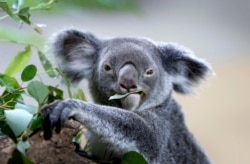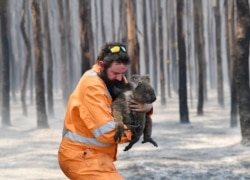Scientists have long wondered how Australia’s koalas get enough water to live. A new study provides an answer.
In the wild, koalas get water from the plant leaves they eat. But they also get it from water running down the side of tree trunks during rainfall -- what we might call “tree-licking.” Scientists have a term for this process -- “stemflow.”
The lead author of the new report on koalas is Valentina Mella of the University of Sydney. It was earlier thought, she explains, that the animals got most of their water from moisture in the leaves they ate.
Mella and other researchers based their findings on 46 observations of koalas in the wild from 2006 to 2019. Most of the animals were observed at You Yangs Regional Park in the Australian state of Victoria.
Mella notes that koalas are largely nocturnal animals. This means they are active at night.
“They are arboreal,” adds Mella. This means they live in trees and rely on them for food, shelter and, as the researchers just discovered, also for drinking.
Koalas spend most of their lives high up in eucalyptus trees. They eat large amount of eucalyptus leaves. An adult koala normally eats between 500 to 800 grams of leaves a day.
Because of their diet, koalas sleep a lot -- about 20 hours a day. Their diet of tree leaves requires much energy to digest.
Mella notes that “koalas actually spend 98% of their lives in trees.” She adds that the only time they come down to the ground is to find another tree with better food supplies or a mate.
In fact, the word “koala” is said to have come from an Aboriginal word meaning ‘no drink.’ Koalas did not go down onto the ground very often. So, it was thought that they had no need to drink water.
The researchers published their findings in the journal Ethology. They said the study may be useful in efforts to protect koalas for future generations.
Mella says that the “observations in the wild are very important.” She adds that they can help to establish what is normal and what is not.
“If we watch them carefully,” she says, “they will tell us.”
Koalas have been under threat due to a loss of their natural habitat. Australia’s environment minister told the Australian Broadcasting Corporation that recent wildfires have destroyed “up to 30% of their habitat.”
I’m Anna Matteo.
Will Dunham reported this story for the Reuters news agency. Anna Matteo adapted it for VOA Learning English. George Grow was the editor.
________________________________________________________________
Words in This Story
leaf – n. one of the flat and typically green parts of a plant that grow from a stem or twig
lick – v. to draw the tongue over
moisture – n. a small amount of a liquid (such as water) that makes something wet or moist
nocturnal – adj. active at night
arboreal – adj. living in or often found in trees
digest – v. to change or become changed into simpler forms that can be used by the body
habitat – n. the place or environment where a plant or animal naturally or normally lives and grows










